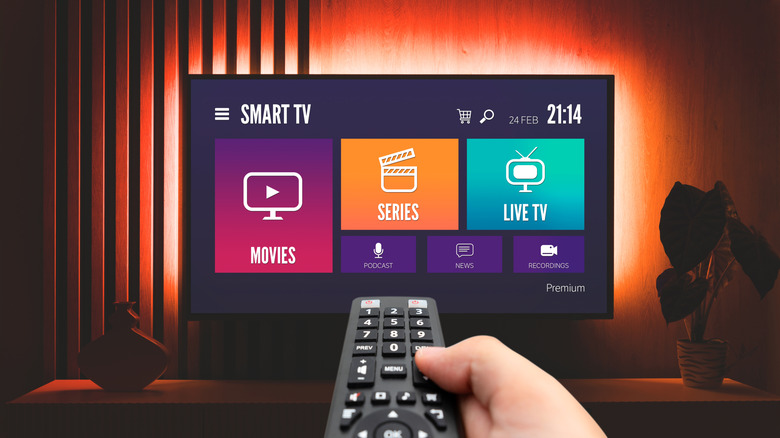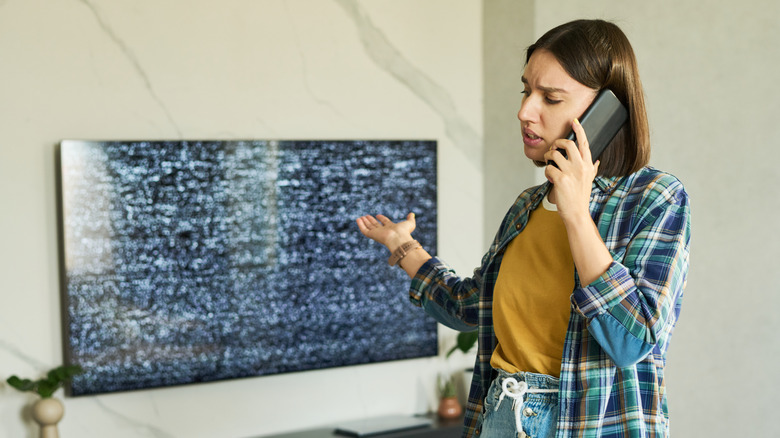How Long Do Cheap TVs Really Last? Here's What Users Say
The television is a ubiquitous part of the modern household. Chances are that you probably own multiple televisions, one for each bedroom in your home. Over the years, the cost of many televisions has come down as advancements in technology have made production cheaper. It's not uncommon to find a large 65-inch 4K UHD television on sale for under $300 at your local big box retailer, with Costco even featuring a budget-friendly 100-inch television.
But just how long do these lower-cost televisions last, especially when they are packed with so many features? There are certain pieces of technology that many of us replace on a fairly regular basis, but historically, televisions haven't been replaced all that often. It's not uncommon for users to own a television for anywhere from 5-10 years. Still, many feel that modern televisions don't last quite as long as they used to. As someone who daily drives a 27-inch Panasonic CRT from 2001, I can say this from experience.
Back in November of 2023, I purchased two brand new 65-inch TCL Roku televisions, both of which failed within a year of purchase and only months apart. One featured a single burnt LED, which caused all the lights to go out; the other suffered a blown capacitor, leading to a dead picture. Thankfully, both were easy enough to fix, but only because I have experience in electronics repair. A normal user would have certainly gone out and purchased a new television.
You should expect around 45,000 hours of use
Electronics can be fickle beasts. I was unlucky enough to have a defective Nintendo Wii on launch day, something very rare as the console only featured a 2.7% failure rate. When it comes to modern televisions, cost has a lot to do with how long your television may last. You should expect to get around 45,000 hours of screen time on lower-end televisions. More expensive units, like ones from LG, often claim 100,000 hours before reaching their end of life. And chances are the backlight will be the first part to fail on cheaper units.
When it comes to cheaper televisions, you are mostly saving money on the components and on the lack of rigorous quality control. Consumers often cite low-cost brands such as RCA and Insignia as having reliability issues, with other brands such as Amazon and Roku having problems with built-in software. One big issue with cheaper televisions is their power supplies. Cheap sets tend to use cheaper parts, so if your home suffers from dirty power, you'll see higher failure rates on lower-end TVs.
Software is also a problem on many cheaper smart televisions. When using a streaming stick, you can always upgrade and move to a different streaming device when things get slow or new technology comes along. With a cheap smart television, you are stuck with the built-in software, often relying on a guide to help you fix a slow smart TV.
Dumb TVs might be your best bet
Your best bet is to find the non-smart version of a TV model that you like. These are often listed as "hospitality" TVs on various retail sites, and you can easily add a streaming stick to get all your apps and several free TV channels. Most processors on these cheap televisions simply aren't powerful enough to provide a great picture and keep up with the built-in software. Add in the fact that included apps may not get any software updates, and you can end up with a television that may become obsolete before failing outright.
The proliferation of low-end televisions has begun to turn the industry into consumable devices, encouraging consumers to upgrade every few years. A company can make more money by having the consumer come back every few years to purchase a new television, spending more in the long run. With a higher-end television, you will likely have a better viewing experience alongside a set that lasts much longer.
That said, many users love their cheaper televisions from brands like TCL, Vizio, and Hisense. A cheap television can be made to look decent if you know how to play around with the settings, only being outclassed when you see one side-by-side alongside a high-end unit. The general consensus is that you should spend more on a quality television for your main living area and rely on a cheaper unit for bedrooms and garage/patio use.


